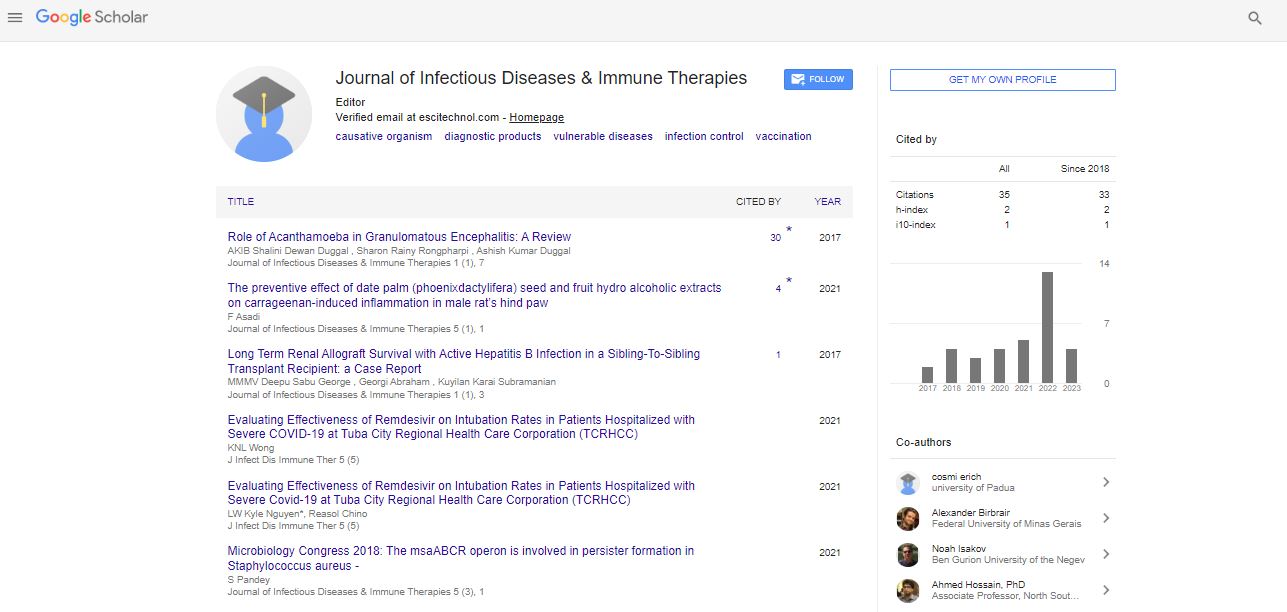Opinion Article, J Aging Geriatr Med Vol: 7 Issue: 3
Recent Advancements in Diagnosis and Laboratory Techniques for Meningitis
Suzuma Mori*
1Department of Infectious Diseases, Keio University School of Medicine, Tokyo, Japan
*Corresponding Author: Suzuma Mori,
Department of Infectious Diseases, Keio
University School of Medicine, Tokyo, Japan
E-mail: sumori@ncc.go.jp
Received date: 28 August, 2023, Manuscript No. JIDITH-23-117448;
Editor assigned date: 30 August, 2023, PreQC No. JIDITH-23-117448 (PQ);
Reviewed date: 13 September, 2023, QC No. JIDITH-23-117448;
Revised date: 21 September, 2023, Manuscript No. JIDITH-23-117448 (R);
Published date: 29 September, 2023, DOI: 10.4172/2329-9541.1000352
Citation: Mori S (2023) Recent Advancements in Diagnosis and Laboratory Techniques for Meningitis. J Infect Dis Immune Ther 7:3.
Description
Meninges are the protective membranes that surround the brain and spinal cord, and meningitis is an inflammatory disease that damages them. The dura mater, arachnoid mater, and pia mater are the names of these membranes. Meningitis may result from bacterial, viral, or fungal infections as well as non-infectious causes such chemical irritants, drug interactions, or underlying medical disorders. Many people fear meningitis since it is a serious medical condition. It has become a source of worry and intrigue due to its reputation for quick onset, intense symptoms, and possibly disastrous outcomes. Clinical assessment, a lumbar puncture to examine cerebrospinal fluid, and numerous laboratory testing are required for the diagnosis of meningitis. Treatment after diagnosis depends on the underlying cause. Some of the bacterial strains are the subject of vaccines.
Forms of meningitis
Viral meningitis: This type of meningitis is typically less severe than bacterial meningitis. It's often caused by viruses such as enteroviruses and herpes simplex virus. Viral meningitis usually resolves on its own and doesn't require specific antibiotic treatment. Typically managed with supportive care, as most cases resolve on their own.
Bacterial meningitis: If not treated quickly, bacterial meningitis can be fatal and is a more serious condition. Streptococcus pneumoniae, Neisseria meningitides, and Haemophilus influenza are typical bacteria that can cause bacterial meningitis. Antibiotic therapy is frequently necessary for the treatment of bacterial meningitis. Hospitalization and the administration of antibiotics are necessary to tackle the implicated bacterial strain.
Fungal meningitis: Fungal meningitis is rare and typically occurs in individuals with weakened immune systems. It is caused by fungi such as Cryptococcus. Usually necessitates antifungal medication, and the treatment can be lengthy.
Non-infectious causes: Chemical irritants, drug reactions, and underlying medical conditions can lead to non-infectious meningitis.
Molecular diagnostics
Molecular diagnostics have ushered in a new era in the identification of meningitis causative agents. Polymerase Chain Reaction (PCR) and Nucleic Acid Amplification Tests (NAATs) have demonstrated exceptional sensitivity and specificity, allowing for rapid and precise identification of pathogens. PCR-based assays have been developed for various bacterial strains responsible for meningitis, including Streptococcus pneumoniae, Neisseria meningitides, and Haemophilus influenza. These tests provide highly accurate results within hours, enabling prompt treatment. PCR has also greatly improved the diagnosis of viral meningitis. Enteroviruses, herpes simplex virus, and other viral agents can be quickly and accurately identified, differentiating viral from bacterial cases. Molecular techniques can sub-type bacterial strains, aiding in epidemiological studies and monitoring of outbreaks. Advanced imaging techniques play a vital role in the evaluation and diagnosis of meningitis. Magnetic Resonance Imaging (MRI) and Computed Tomography (CT) scans provide valuable insights into the structural changes and complications associated with the condition. MRI is highly sensitive in detecting meningeal inflammation and abnormalities. It can reveal cerebral edema, infarctions, and hydrocephalus, aiding in early intervention and treatment planning. CT scans are particularly useful in emergencies, offering quick assessments of increased intracranial pressure, hemorrhages, or abscesses. Advanced MRI techniques like perfusion and diffusion imaging provide insights into cerebral blood flow and tissue changes, enhancing diagnostic accuracy.
Conclusion
The recent advancements in molecular diagnostics and advanced imaging techniques have significantly improved our ability to diagnose and manage meningitis. Rapid and accurate identification of the causative agents, differentiation between viral and bacterial forms, and insights into structural changes and complications are all made possible through these innovations. While challenges persist, ongoing studies and development promise to further enhance the diagnosis and treatment of this vital condition.
 Spanish
Spanish  Chinese
Chinese  Russian
Russian  German
German  French
French  Japanese
Japanese  Portuguese
Portuguese  Hindi
Hindi 